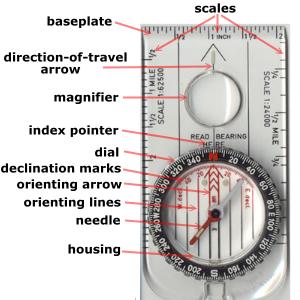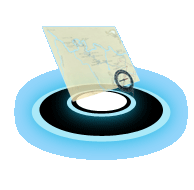







|
|
Many people rely on GPS; however GPS systems are expensive and require batteries. Compasses are the exact opposite where they are cheap compare to
GPS units and do not require batteries. A compass can also allow the scout to orientate a map and help identify features on the landscape. The
question remains, how do I select the best compass for me? There are many different types of compasses out there all with their own uses,
specialties, and cost. This section breaks down different compasses and also the parts that make up the compass.
|
All compasses are the same
The most common type of compass is the magnetic compass. A magnetic compass interacts with Earth’s magnetic field to point to the magnetic pole.
These compasses are normally filled with a liquid to protect the compass from shock, and to dampen vibrations which allow the needle to settle and
point towards North quicker.
There are different versions to the traditional magnetic compasses. These are separated by their functionality and design and are as follows:
- Accessory Compass - These are compasses that are normally found on key chains and flashlights. While they do point to magnetic North, these should not replace a basic compass or be used as part of a Scout’s Ten Essentials.
- Basic Compass - Basic compasses are, as their name implies, a compass with basic functionality, and do not have the bells and whistles like the more advanced models do. This is a good choice for Scouts that are just starting out and would not use the more advanced functions.
- Advanced Compass - Advanced models are fully loaded and come with many different tools thatmake navigation easier and more accurate. These tools include magnifying glass, mirror, and declination adjustment which the basic compasses lack.
Once you have determined the compass that is best suited to you, you can start to determine the different parts of the compass.
|
Parts of a compass
Whichever model you decide on using, you must know the different parts of the compass and know what each item does before you can use the
compass. The section below breaks down the different parts of a compass and also gives an explanation to what each item does.
1. Magnetic Needle – The magnetic needle is the needle that floats in liquid, spins around, and finds magnetic North. This needle is normally red and white with the red portion pointing north; different variations may exist.
2. Capsule – The capsule is the housing that houses the liquid and the magnetic needle.
3. Rotating Bezel – Also known as an azimuth ring is the rotating dial that is marked with degrees from 0 to 360. The ring is used by the user to input the direction of travel, or degree, which is relative to magnetic north.
4. Base plate – The base plate is the base that the capsule sits upon. Some compasses also have the magnifying glass and ruler built into the base plate which is extremely helpful when measuring distances on a map or drawing a bearing.
5. Orienteering Arrow – The orienteering arrow is a drawn arrow located on the bottom of the capsule. The arrow on the bottom of the capsule is used to align the user to the direction of travel and is normally paired with meridian lines which are used to orient the compass to the map.
6. Direction of Travel – The direction of travel is the large arrow that is printed on the edge of the base plate. As the name implies, after the compass has been calibrated to a specific degree, the direction of travel points to the bearing that it is configured to.
7. Magnifying Lens – Certain compasses have magnifying lenses built into the base plate that allows the user to read maps easier.
These are just some basic parts of a compass. There are compasses that posses more parts and some with less parts. The image below is a sample of where these and other parts of a compass would be located.
|

|
|
Now that you have selected a compass and also identify the parts and features of your compass, you can check out the different sections to learn
how to use this valuable tool. A compass is an essential tool. That is why it is in the Boy Scouts' ten essential listing. By learning how to
efficiently use this tool, you can make your experience in the outdoors safer and much more enjoyable.
|
|















